Time-Aware Service Ranking Prediction in the Internet of Things Environment
Abstract
:1. Introduction
- (1)
- The time-aware service ranking prediction approach is proposed to obtain the global ranking, which can obtain the service ranking by studying the temporal dynamic changes of QoS.
- (2)
- During the process of our approach, the temporal dynamic changes of QoS attributes are studied by time series forecasting method, which can forecast the future values and dynamic trends using fitted models.
- (3)
- A random walk model is constructed based on pairwise comparison model, which is used to obtain the global service ranking from collection of partial rankings by considering the differentials of QoS values.
2. Preliminaries
3. Model of Service Ranking Prediction
3.1. Framework
3.2. Pairwise Comparison Model
3.3. Time Series Forecasting
- Step 1
- White noise checking. Before constructing ARIMA models, we should check whether the original time series data has white noise. If they do not satisfy the condition of white noise, we need perform the following steps, otherwise, the simple moving average approach is adopted to obtain the future values.
- Step 2
- Stationarity checking. The stationarity checking is the pre-condition of model identification. If the time series has non-stationarity, d differences should be done to transform the original time series into a stationary series.
- Step 3
- Model identification. In this step, the key issue is how to determine the order of p and q. We need determine the concrete orders of the ARIMA model according to the observation of autocorrelation function (ACF) and partial autocorrelation function (PACF).
- Step 4
- Model estimation. After we determine the order for ARIMA, we need determine the parameters of identified models to provide the best fit to the time series data.
- Step 5
- Model checking. Model checking involves the diagnostic checking for model adequacy. In this process, we should check the significance of the candidate models and their associated parameters.
- Step 6
- Model selection. Once all candidate models are estimated and checked, the best model is selected based on Akaike’s information criterion (AIC).
- Step 7
- Forecasting. Since the ARIMA model is modeled, the future QoS differentials can be obtained according to the fitted model.
3.4. Markov Model for Random Walks
4. Algorithms for Obtaining Global Ranking
- Step 1
- In the first step, our approach selects all services pairs based on the constructed pairwise comparison model.
- Step 2
- The future values of QoS differentials can be estimated by the fitted time series model for obtaining the partial service rankings.
- Step 3
- All partial rankings are aggregated and the transition matrix is calculated by the formula (6).
- Step 4
- Furthermore, DTMC with transition matrix P can be solved by .
- Step 5
- Finally, the global service ranking is derived through steady-state probabilities ranking.
| Algorithm 1 Algorithm for time series forecasting |
| Input: QoS data D Output: Predicted QoS values
|
5. Case Study
5.1. Example of Service Ranking
5.2. Prototype System
6. Evaluation
6.1. Theoretical Analysis
6.2. Experimental Evaluation
6.2.1. Datasets and Evaluation Metrics
6.2.2. Experimental Results
7. Related Work
7.1. Service Ranking
7.2. QoS Prediction
8. Conclusions
Acknowledgments
Author Contributions
Conflicts of Interest
References
- Huang, C.; Wu, C. A Web Service Protocol Realizing Interoperable Internet of Things Tasking Capability. Sensors 2016, 16, 1395. [Google Scholar] [CrossRef] [PubMed]
- Chaves-Díeguez, D.; Pellitero-Rivero, A.; García-Coego, D.; González-Castaño, F.J.; Rodríguez-Hernández, P.S.; Piñeiro-Gómez, Ó.; Gil-Castiñeira, F.J.; Costa-Montenegro, E. Providing IoT Services in Smart Cities through Dynamic Augmented Reality Markers. Sensors 2015, 15, 16083–16104. [Google Scholar] [CrossRef] [PubMed]
- Chen, I.; Guo, J.; Bao, F. Trust Management for SOA-Based IoT and Its Application to Service Composition. IEEE Trans. Serv. Comput. 2016, 9, 482–495. [Google Scholar] [CrossRef]
- Abu-Elkheir, M.; Hayajneh, M.; Ali, N.A. Data Management for the Internet of Things: Design Primitives and Solution. Sensors 2013, 13, 15582–15612. [Google Scholar] [CrossRef] [PubMed]
- Toma, I.; Roman, D.; Fensel, D.; Sapkota, B.; Gómez, J.M. A Multi-criteria Service Ranking Approach Based on Non-Functional Properties Rules Evaluation. In Proceedings of the Fifth International Conference of Service-Oriented Computing (ICSOC 2007), Vienna, Austria, 17–20 September 2007; pp. 435–441. [Google Scholar]
- Zheng, Z.; Wu, X.; Zhang, Y.; Lyu, M.R.; Wang, J. QoS Ranking Prediction for Cloud Services. IEEE Trans. Parallel Distrib. Syst. 2013, 24, 1213–1222. [Google Scholar] [CrossRef]
- Huang, J.; Chen, Y.; Lin, C.; Chen, J. Ranking Web Services with Limited and Noisy Information. In Proceedings of the 2014 IEEE International Conference on Web Services (ICWS 2014), Anchorage, AK, USA, 27 June–2 July 2014; pp. 638–645. [Google Scholar]
- Box, G.E.P.; Jenkins, G.M. Time Series Analysis: Forecasting and Control, 5th ed.; Wiley: New York, NY, USA, 2015. [Google Scholar]
- Ammar, A.; Shah, D. Ranking: Compare, don’t score. In Proceedings of the 2011 49th Annual Allerton Conference on Communication, Control, and Computing (Allerton 2011), Monticello, IL, USA, 28–30 September 2011; pp. 776–783. [Google Scholar]
- Negahban, S.; Oh, S.; Shah, D. Iterative ranking from pair-wise comparisons. In Proceedings of the 26th Annual Conference on Neural Information Processing Systems, Lake Tahoe, NV, USA, 3–6 December 2012; pp. 2483–2491. [Google Scholar]
- Amin, A.; Grunske, L.; Colman, A. An automated approach to forecasting QoS attributes based on linear and non-linear time series modeling. In Proceedings of the IEEE/ACM International Conference on Automated Software Engineering (ASE 12), Essen, Germany, 3–7 September 2012; pp. 130–139. [Google Scholar]
- Gibbons, J.D.; Chakraborti, S. Nonparametric Statistical Inference, 5th ed.; CRC: Boca Raton, FL, USA, 2010. [Google Scholar]
- Wolters, J.; Hassler, U. Unit root testing. Allg. Stat. Arch. 2006, 90, 43–58. [Google Scholar]
- Akaike, H. Maximum likelihood identification of Gaussian autoregressive moving average models. Biometrika 1973, 60, 255–265. [Google Scholar] [CrossRef]
- Dhillon, I.S.; Parlett, B.N.; Vömel, C. The design and implementation of the MRRR algorithm. ACM Trans. Math. Softw. 2006, 32, 533–560. [Google Scholar] [CrossRef]
- Zhang, Y.; Zheng, Z.; Lyu, M.R. WSPred: A Time-Aware Personalized QoS Prediction Framework for Web Services. In Proceedings of the IEEE 22nd International Symposium on Software Reliability Engineering, (ISSRE 2011), Hiroshima, Japan, 29 November–2 December 2011; pp. 210–219. [Google Scholar]
- Zheng, Z.; Zhang, Y.; Lyu, M.R. Investigating QoS of Real-World Web Services. IEEE Trans. Serv. Comput. 2014, 7, 32–39. [Google Scholar] [CrossRef]
- Zhao, S.; Yu, L.; Cheng, B. A Real-Time Web of Things Framework with Customizable Openness Considering Legacy Devices. Sensors 2016, 16, 1596. [Google Scholar] [CrossRef] [PubMed]
- Groggel, D.J. Analyzing and Modeling Rank Data; Chapman & Hall: London, UK, 1996; p. 403. [Google Scholar]
- Al-Masri, E.; Mahmoud, Q.H. QoS-based Discovery and Ranking of Web Services. In Proceedings of the 16th International Conference on Computer Communications and Networks (ICCCN 2007), Turtle Bay Resort, Honolulu, HI, USA, 13–16 August 2007; pp. 529–534. [Google Scholar]
- Yau, S.; Yin, Y. QoS-Based Service Ranking and Selection for Service-Based Systems. In Proceedings of the 8th IEEE International Conference on Services Computing (SCC 2011), Washington, DC, USA, 4–9 July 2011; pp. 56–63. [Google Scholar]
- Mei, L.; Chan, W.; Tse, T.H. An Adaptive Service Selection Approach to Service Composition. In Proceedings of the 6th IEEE International Conference on Web Services (ICWS 2008), Beijing, China, 23–26 September 2008; pp. 70–77. [Google Scholar]
- Zhou, Y.; Liu, L.; Perng, C.S.; Sailer, A.; Silva-Lepe, I.; Su, Z. Ranking Services by Service Network Structure and Service Attributes. In Proceedings of the 20th IEEE International Conference on Web Services (ICWS 2013), Santa Clara, CA, USA, 28 June–3 July 2013; pp. 26–33. [Google Scholar]
- Zheng, Z.; Zhou, T.; Lyu, M.; King, I. Component Ranking for Fault-Tolerant Cloud Applications. IEEE Trans. Serv. Comput. 2012, 5, 540–550. [Google Scholar] [CrossRef]
- Liu, N.N.; Yang, Q. EigenRank: A ranking-oriented approach to collaborative filtering. In Proceedings of the 31st Annual International ACM SIGIR Conference on Research and Development in Information Retrieval (SIGIR 2008), Singapore, 20–24 July 2008; pp. 83–90. [Google Scholar]
- Zheng, Z.; Ma, H.; Lyu, M.; King, I. QoS-Aware Web Service Recommendation by Collaborative Filtering. IEEE Trans. Serv. Comput. 2011, 4, 140–152. [Google Scholar] [CrossRef]
- Tang, M.; Jiang, Y.; Liu, J.; Liu, X. Location-Aware Collaborative Filtering for QoS-Based Service Recommendation. In Proceedings of the 19th IEEE International Conference on Web Services (ICWS 2012), Honolulu, HI, USA, 24–29 June 2012; pp. 202–209. [Google Scholar]
- Costa, G.; Ortale, R. Model-Based Collaborative Personalized Recommendation on Signed Social Rating Networks. ACM Trans. Internet Technol. 2016, 16, 20. [Google Scholar] [CrossRef]
- Ma, Y.; Wang, S.; Hung, P.C.K.; Hsu, C.; Sun, Q.; Yang, F. A Highly Accurate Prediction Algorithm for Unknown Web Service QoS Values. IEEE Trans. Serv. Comput. 2016, 9, 511–523. [Google Scholar] [CrossRef]
- Zhang, W.; Sun, H.; Liu, X.; Guo, X. Incorporating Invocation Time in Predicting Web Service QoS via Triadic Factorization. In Proceedings of the 2014 IEEE International Conference on Web Services (ICWS 2014), Anchorage, AK, USA, 27 June–2 July 2014; pp. 145–152. [Google Scholar]
- Yu, C.; Huang, L. Time-Aware Collaborative Filtering for QoS-Based Service Recommendation. In Proceedings of the 2014 IEEE International Conference on Web Services (ICWS 2014), Anchorage, AK, USA, 27 June–2 July 2014; pp. 265–272. [Google Scholar]
- Hu, Y.; Peng, Q.; Hu, X. A Time-Aware and Data Sparsity Tolerant Approach for Web Service Recommendation. In Proceedings of the 2014 IEEE International Conference on Web Services (ICWS 2014), Anchorage, AK, USA, 27 June–2 July 2014; pp. 33–40. [Google Scholar]
- Zhu, S.; Du, Z.; Chen, Y.; Chai, X.; Li, B.H. QoS Enhancement for PDES Grid Based on Time Series Prediction. In Proceedings of the Sixth International Conference on Grid and Cooperative Computing (GCC 2007), Urumchi, Xinjiang, China, 16–18 August 2007; pp. 423–429. [Google Scholar]
- Li, M.; Huai, J.; Guo, H. An Adaptive Web Services Selection Method Based on the QoS Prediction Mechanism. In Proceedings of the 2009 IEEE/WIC/ACM International Conference on Web Intelligence (WI 2009), Milan, Italy, 15–18 September 2009; pp. 395–402. [Google Scholar]
- Godse, M.; Bellur, U.; Sonar, R.M. Automating QoS Based Service Selection. In Proceedings of the IEEE International Conference on Web Services (ICWS 2010), Miami, FL, USA, 5–10 July 2010; pp. 534–541. [Google Scholar]
- Amin, A.; Colman, A.; Grunske, L. An Approach to Forecasting QoS Attributes of Web Services Based on ARIMA and GARCH Models. In Proceedings of the 2012 IEEE 19th International Conference on Web Services (ICWS 2012), Honolulu, HI, USA, 24–29 June 2012; pp. 74–81. [Google Scholar]
- Li, J.; Luo, X.; Xia, Y.; Han, Y.; Zhu, Q. A time series and reduction-based model for modeling and QoS prediction of service compositions. Concurr. Comput. Pract. Exp. 2015, 27, 146–163. [Google Scholar] [CrossRef]
- Hu, Y.; Peng, Q.; Hu, X.; Yang, R. Web Service Recommendation Based on Time Series Forecasting and Collaborative Filtering. In Proceedings of the 2015 IEEE International Conference on Web Services (ICWS 2015), New York, NY, USA, 27 June–2 July 2015; pp. 233–240. [Google Scholar]
- Ye, Z.; Mistry, S.; Bouguettaya, A.; Dong, H. Long-Term QoS-Aware Cloud Service Composition Using Multivariate Time Series Analysis. IEEE Trans. Serv. Comput. 2016, 9, 382–393. [Google Scholar] [CrossRef]

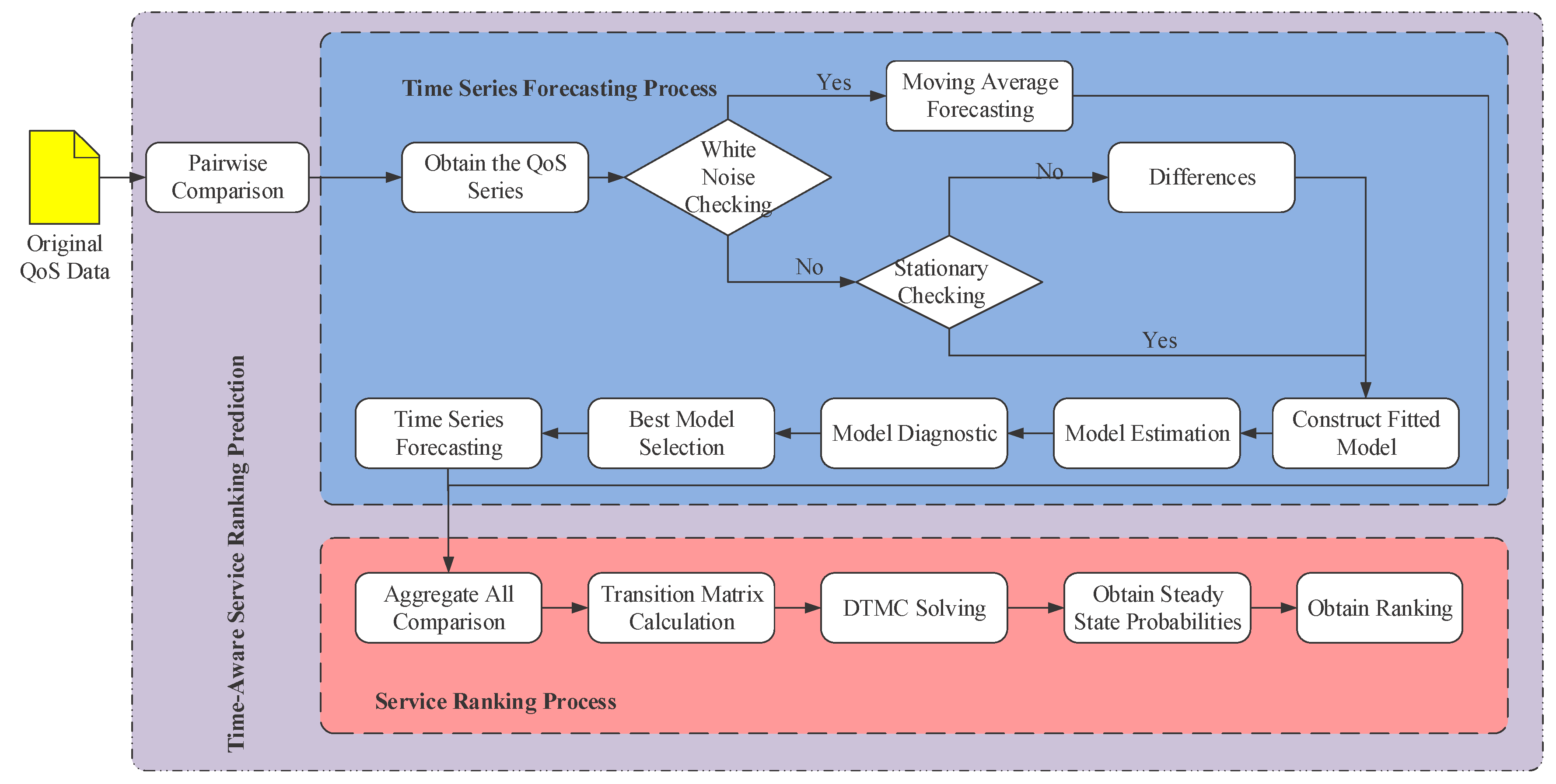
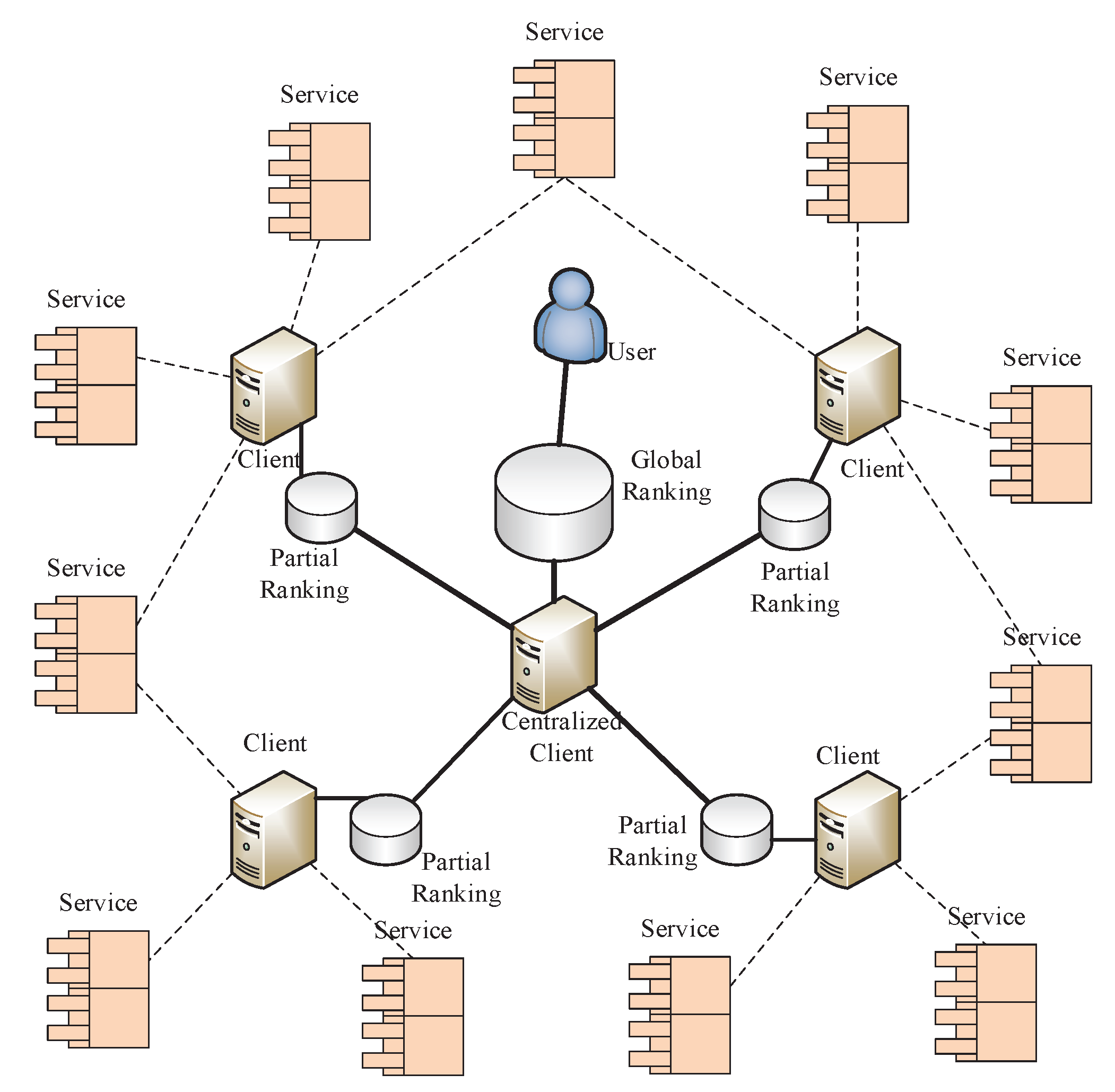
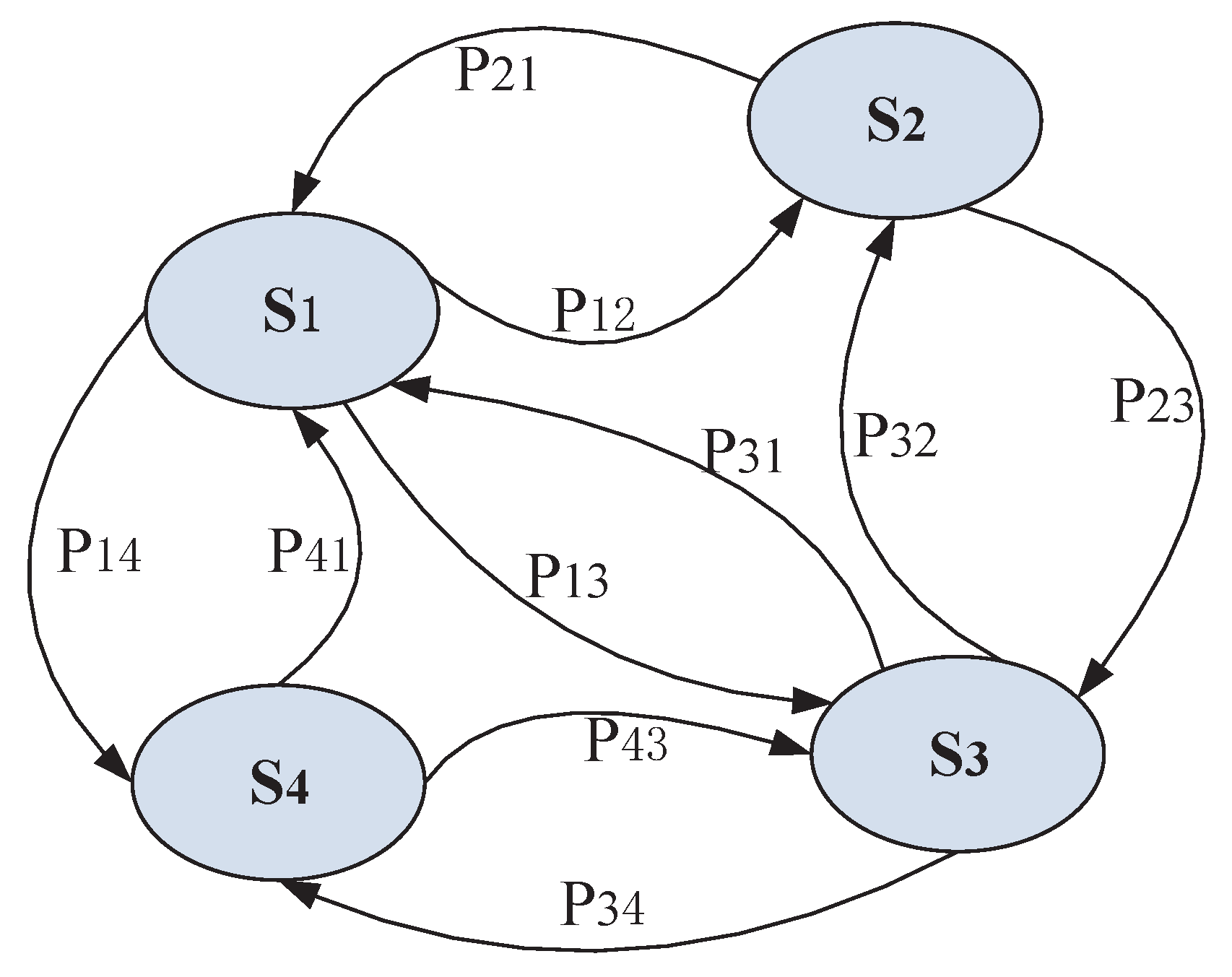
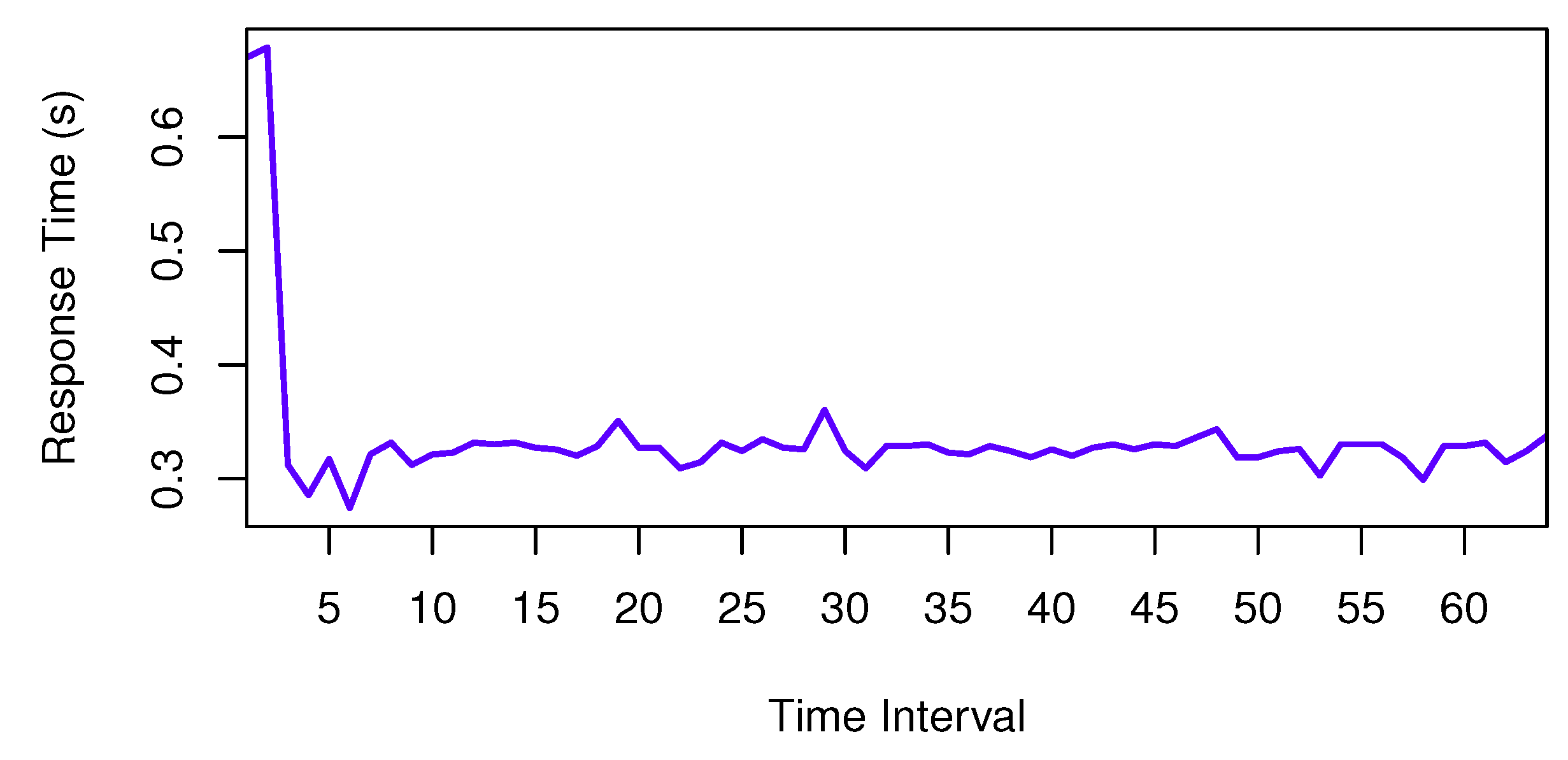

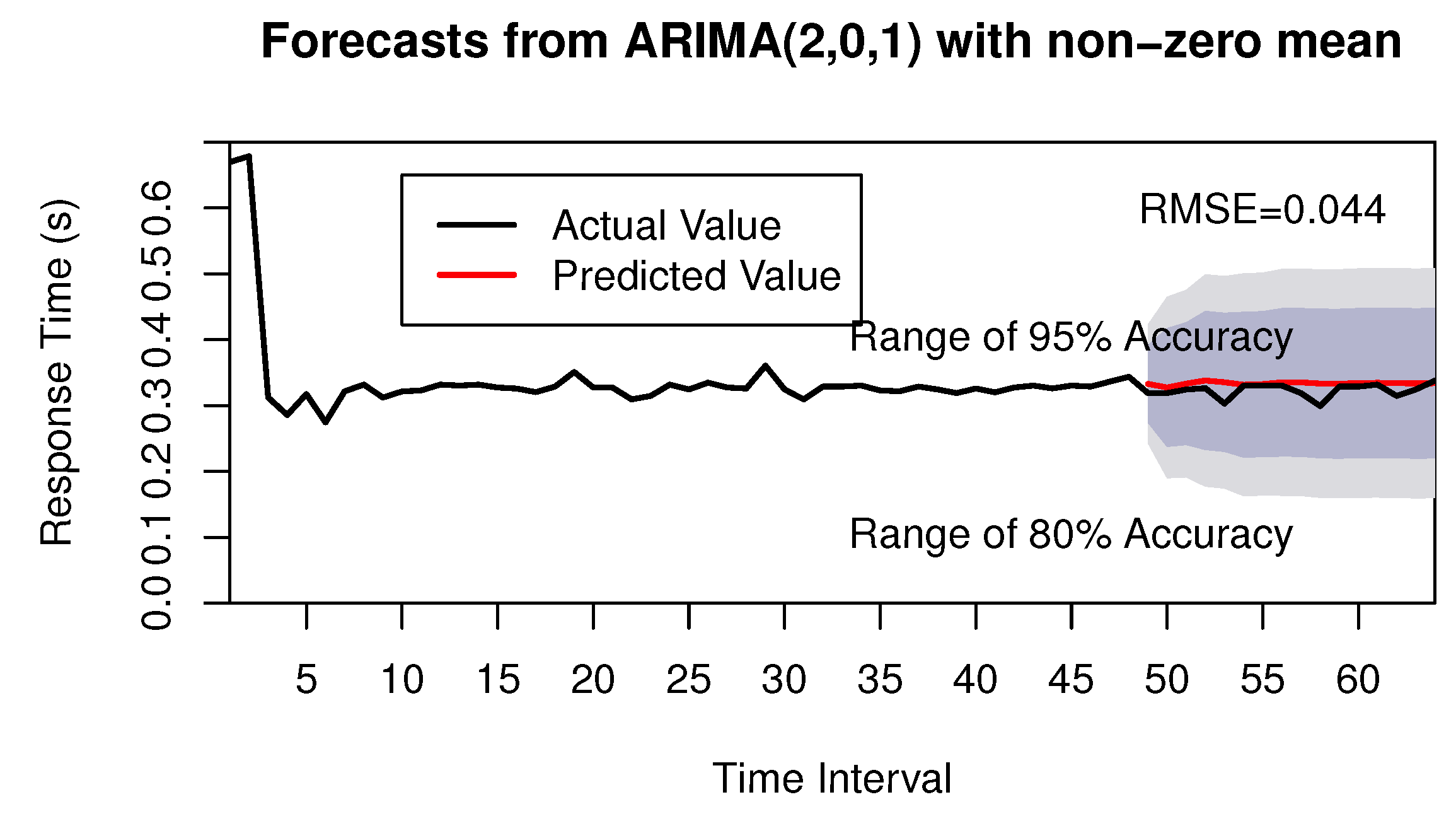
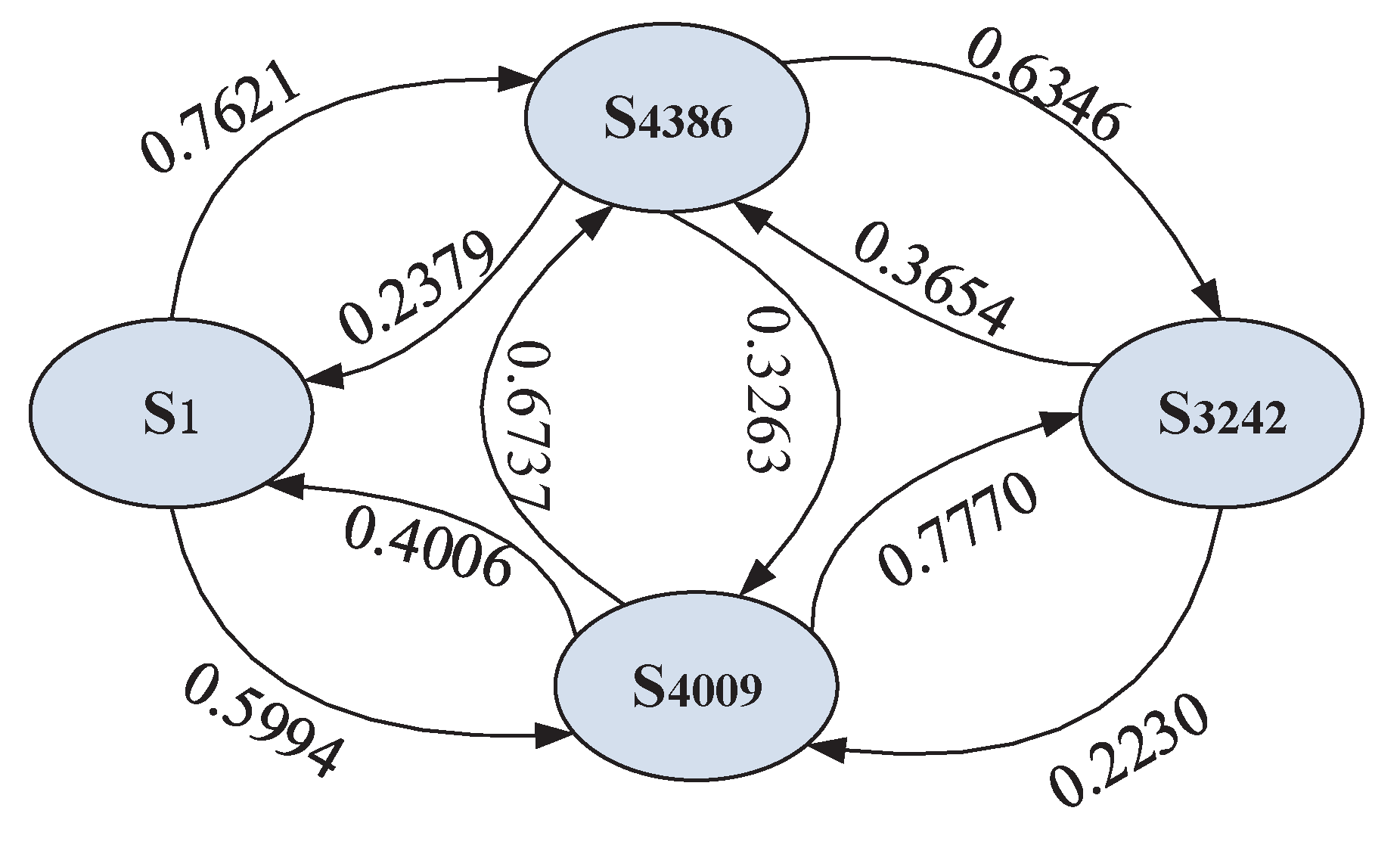

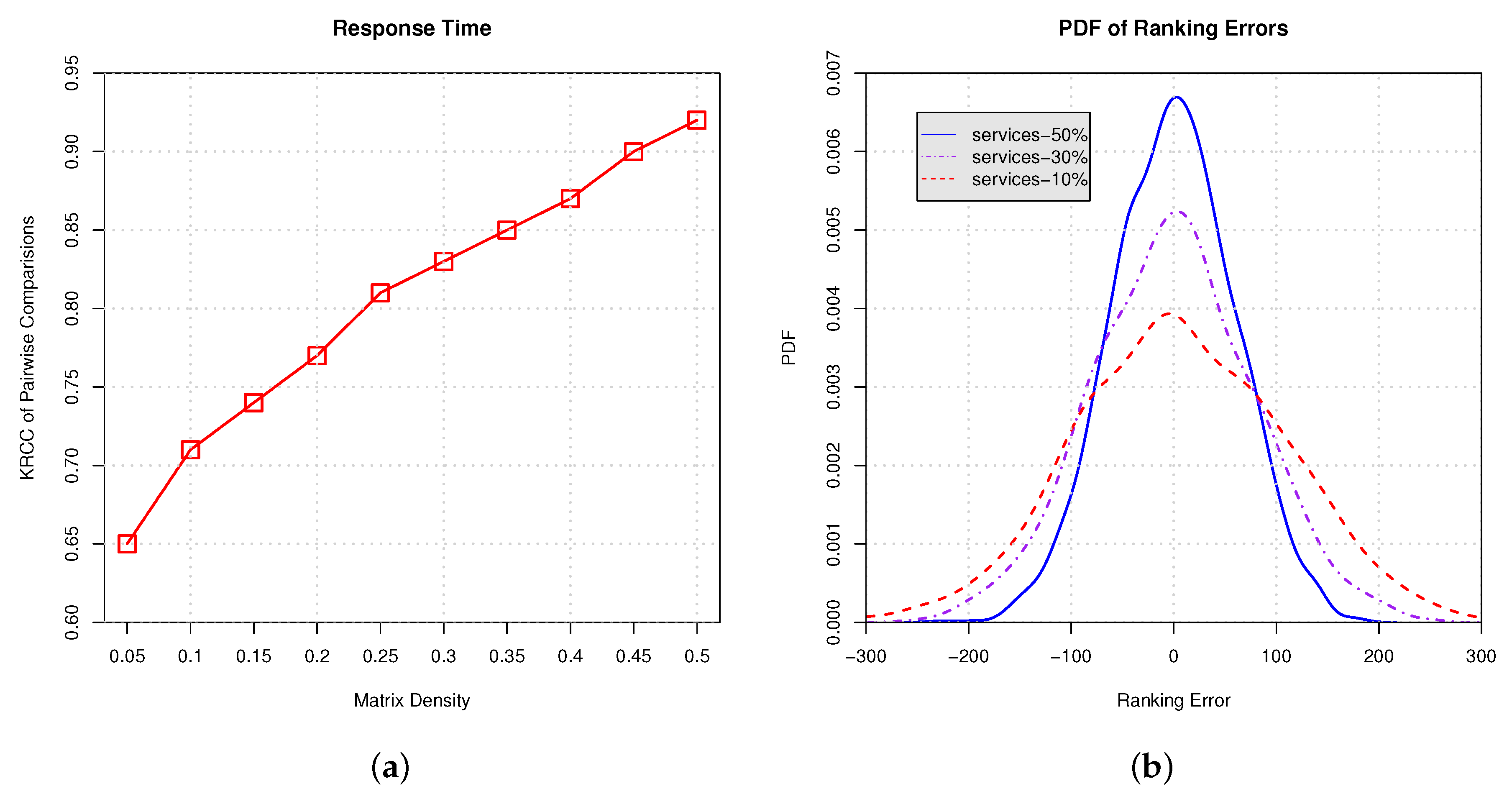
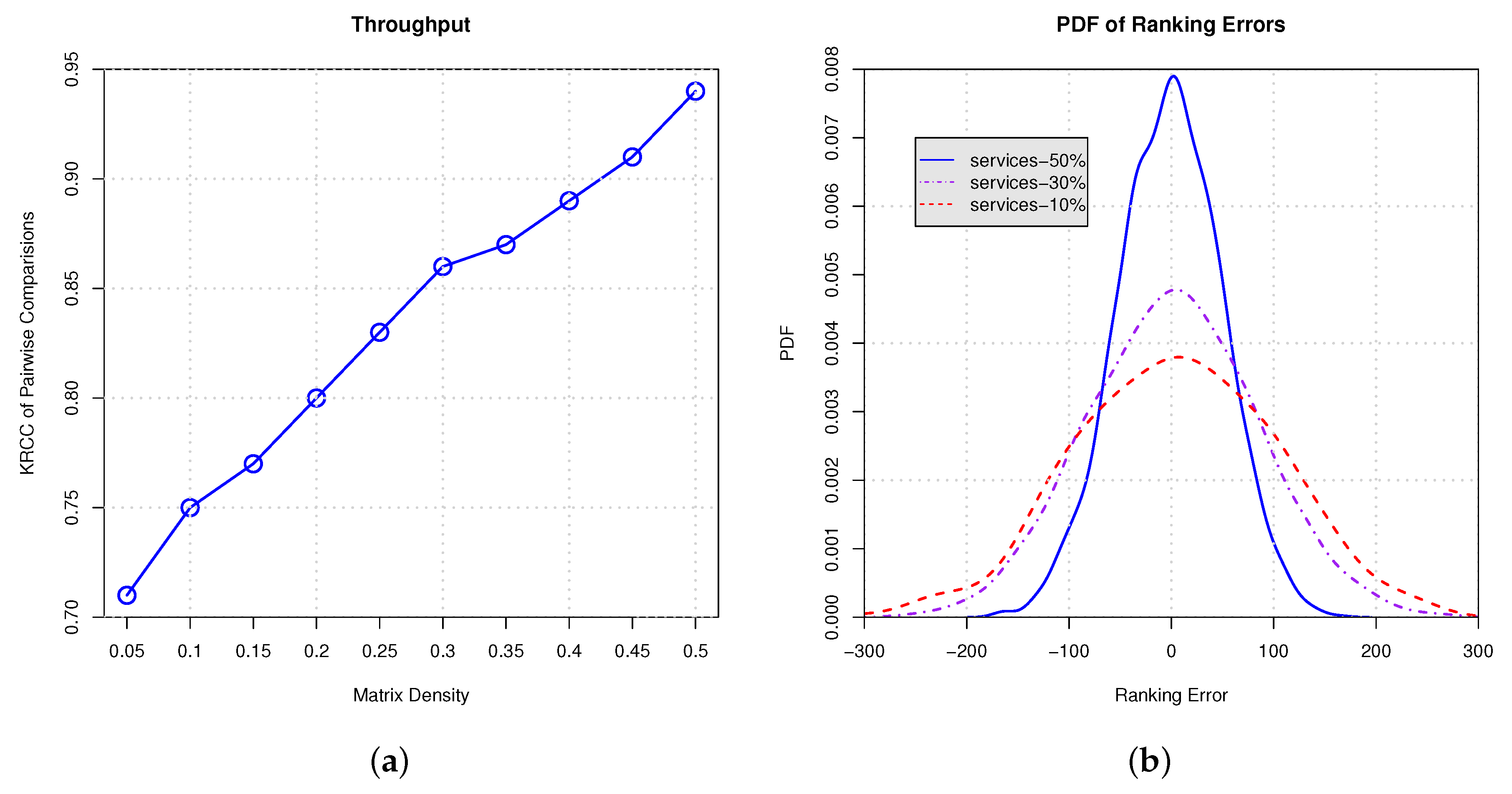
| Models | ACF | PACF |
|---|---|---|
| AR(p) | Decays | Cuts off after lag p |
| MA(q) | Cuts off after lag q | Decays |
| ARMA(p,q) | Decays | Decays |
| Model | Parameter | Estimation | Std. Error | AIC |
|---|---|---|---|---|
| ARIMA(1,0,0) | AR(1) | 0.8137 | 0.1275 | −135.97 |
| ARIMA(2,0,0) | AR(1) | 0.8545 | 0.1400 | −139.65 |
| AR(2) | −0.7525 | 0.2251 | ||
| ARIMA(2,0,1) | AR(1) | 0.2187 | 0.1394 | −149.24 |
| AR(2) | −0.6506 | 0.2890 | ||
| MA(1) | 0.9349 | 0.0821 | ||
| ARIMA(3,0,1) | AR(1) | 0.2469 | 0.1611 | −147.36 |
| AR(2) | −0.6541 | 0.2946 | ||
| AR(3) | 0.1253 | 0.3684 | ||
| MA(1) | 0.9204 | 0.0896 |
© 2017 by the authors. Licensee MDPI, Basel, Switzerland. This article is an open access article distributed under the terms and conditions of the Creative Commons Attribution (CC BY) license (http://creativecommons.org/licenses/by/4.0/).
Share and Cite
Huang, Y.; Huang, J.; Cheng, B.; He, S.; Chen, J. Time-Aware Service Ranking Prediction in the Internet of Things Environment. Sensors 2017, 17, 974. https://doi.org/10.3390/s17050974
Huang Y, Huang J, Cheng B, He S, Chen J. Time-Aware Service Ranking Prediction in the Internet of Things Environment. Sensors. 2017; 17(5):974. https://doi.org/10.3390/s17050974
Chicago/Turabian StyleHuang, Yuze, Jiwei Huang, Bo Cheng, Shuqing He, and Junliang Chen. 2017. "Time-Aware Service Ranking Prediction in the Internet of Things Environment" Sensors 17, no. 5: 974. https://doi.org/10.3390/s17050974






